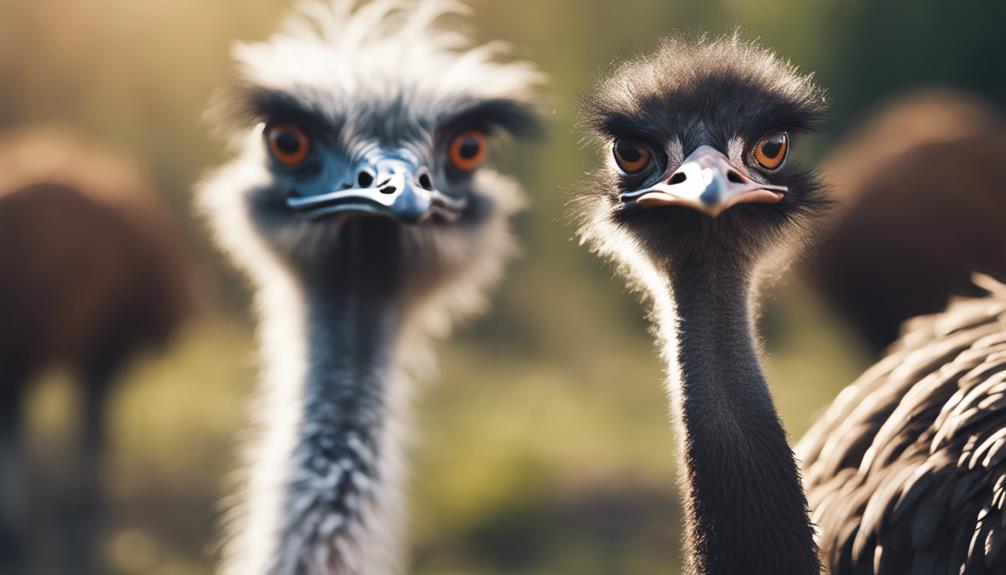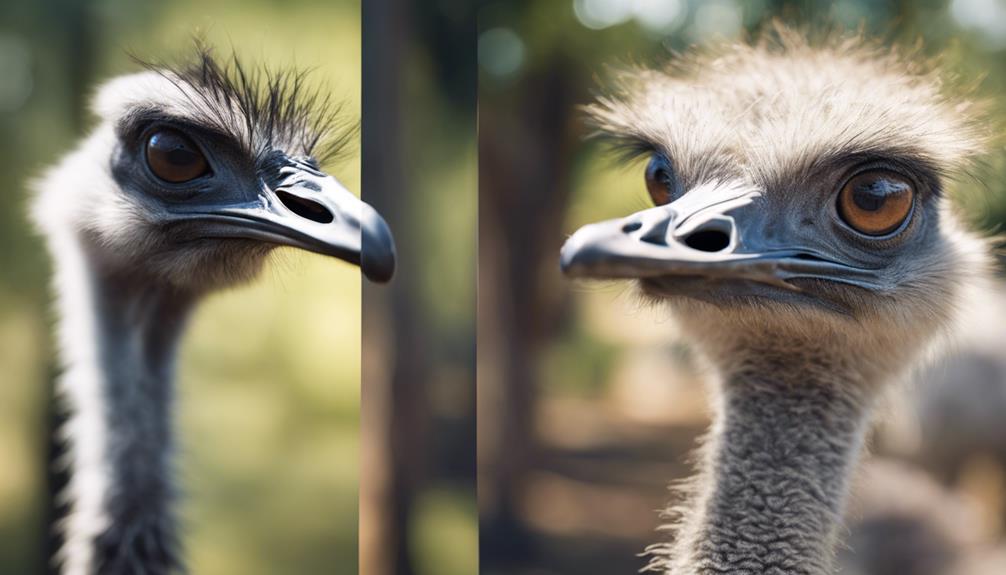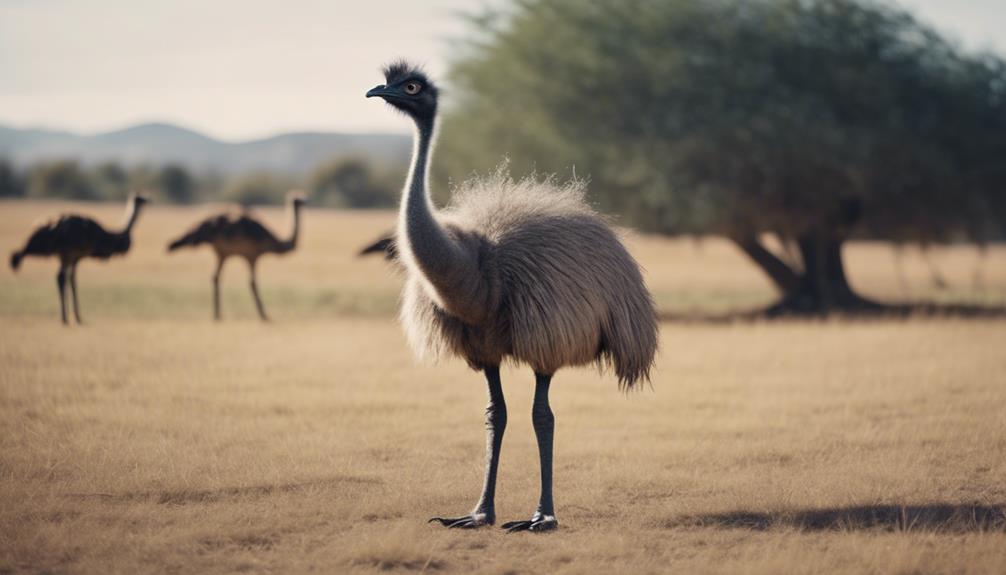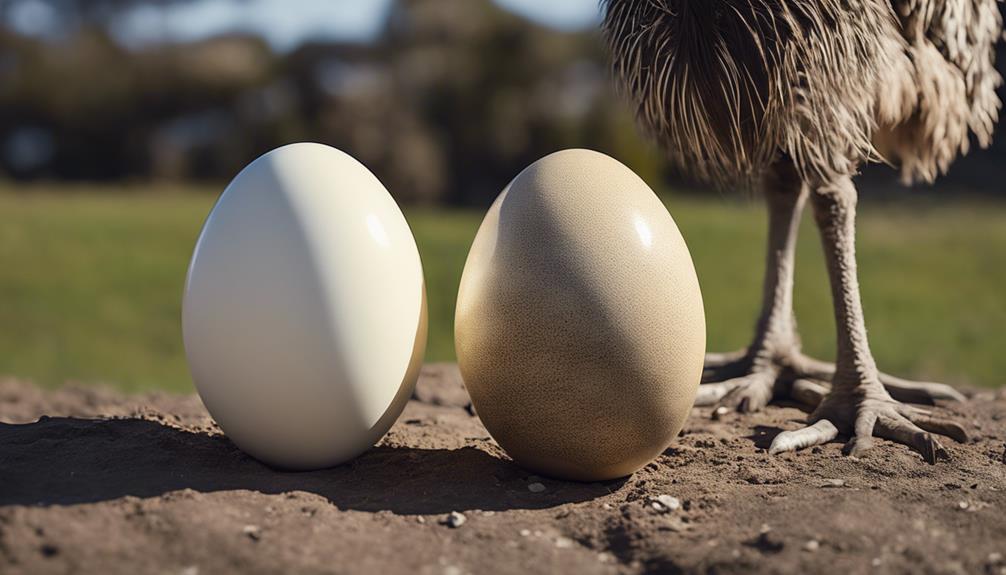
When it comes to the magnificent world of flightless birds, the emu and ostrich stand as majestic giants in their own right.
But have you ever wondered about the subtle nuances that set these two avian wonders apart?
From their physical features to their behaviors and interactions with humans, a deeper exploration into the differences between these two majestic birds might just surprise you.
Key Takeaways
- Emus and ostriches differ in size, with ostriches being taller and heavier.
- Emus prefer temperate habitats, while ostriches thrive in hot, arid environments.
- Emus exhibit monogamous behaviors, while ostriches are polygamous with communal nesting.
- Emus show adaptability to human presence, whereas ostriches can react aggressively, highlighting distinct behavioral traits.
Physical Characteristics

When comparing the physical characteristics of emus and ostriches, it's evident that these two flightless birds share similarities but also possess distinct differences that set them apart. Emus have a more varied feather coloration, ranging from brown to gray, providing them with excellent camouflage in their Australian habitats. In contrast, ostriches display predominantly black feathers that help them blend into the African plains where they reside.
In terms of size differences, emus are slightly smaller than ostriches, standing at around 5 to 6.2 feet tall, while ostriches can reach towering heights of 7 to 9 feet. This variation in size also extends to their weight, with emus weighing between 80 to 130 pounds, whereas ostriches can weigh anywhere from 220 to 350 pounds. These size variations are adaptations that allow each bird to thrive in its respective environment, whether it be the open savannas of Africa or the diverse landscapes of Australia.
Habitat Differences
Emus and ostriches occupy distinct habitats that cater to their specific evolutionary needs, showcasing adaptations tailored to thrive in their respective environments.
- Climate Preferences: Emus prefer a temperate climate and can be found in various habitats such as woodlands, savannas, and grasslands. Ostriches, on the other hand, thrive in hotter climates like deserts and semi-arid areas, where they've evolved to withstand high temperatures.
- Nesting Behaviors: Emus construct shallow nests on the ground, often using twigs and leaves to create a simple structure. In contrast, ostriches build more elaborate nests, digging shallow holes in the sand and lining them with vegetation to provide insulation for their eggs.
- Migration Patterns and Territorial Disputes: Emus are non-migratory birds, establishing territories for breeding and foraging. Ostriches, however, are known to engage in seasonal migrations in search of food and water, sometimes leading to territorial disputes with other ostrich groups.
Understanding these habitat differences sheds light on how these magnificent birds have adapted to their surroundings over time.
Feeding Habits

In contrast to their habitat adaptations, the feeding habits of emus and ostriches further highlight the unique evolutionary strategies these birds have developed to acquire sustenance efficiently. Emus exhibit a broad grazing behavior, consuming a variety of plants, fruits, and insects found in their native grasslands. Their dietary preferences include grasses, seeds, flowers, and small invertebrates, showcasing their adaptability to diverse food sources.
Ostriches, on the other hand, have a more selective feeding strategy, primarily focusing on roots, seeds, and leaves. Their dietary preferences lean towards harder plant materials, reflecting their ability to digest tougher vegetation due to their powerful gizzards. Despite both being flightless birds, emus and ostriches have evolved distinct feeding habits that align with their respective environments and physiological adaptations. Understanding these differences sheds light on the intricate relationship between avian biology and ecological niches, offering insights into the fascinating world of these unique feathered creatures.
Reproduction Variances
Reproductive strategies in emus and ostriches exhibit notable differences in terms of breeding behaviors and nesting practices.
- Mating Behavior: Emus are monogamous, forming long-term bonds with a single partner for each breeding season. In contrast, ostriches are polygamous, with one dominant male mating with multiple females in a communal nest.
- Incubation Period: Emus share the responsibility of incubating their eggs between both the male and female, taking turns every couple of days. This cooperative effort helps ensure the survival of their offspring. On the other hand, ostriches have a unique incubation strategy where the dominant female and male take charge of incubating the eggs during the day and night, respectively, to protect them from predators.
- Nesting Practices: Emus construct simple nests on the ground, relying on camouflage to protect their eggs. In contrast, ostriches build communal nests that can hold up to 60 eggs at a time, with one dominant female laying her eggs alongside those of other females in the group for protection and warmth.
Behavioral Contrasts

When comparing the behavior of emus and ostriches, distinct patterns emerge that highlight their behavioral contrasts in breeding and social dynamics. Emus are known for their solitary nature, often foraging alone or in small groups. In contrast, ostriches are more social animals, forming larger flocks and exhibiting complex social interactions. This difference in social behavior is evident in their communication cues; while emus rely on low-frequency booming sounds to communicate over long distances, ostriches use a range of vocalizations and displays to convey messages within their groups.
Nesting behaviors also vary between emus and ostriches. Emus construct simple nests on the ground, with males taking the primary role in incubating the eggs. On the other hand, ostriches build more elaborate nests and share nesting duties between males and females. Additionally, territorial displays differ between the two species, with emus establishing territories through physical posturing and movements, while ostriches rely on vocalizations and feather displays to defend their space. These behavioral differences shed light on the unique adaptations and social structures of emus and ostriches.
Vocalization Varied
The vocalizations of emus and ostriches exhibit distinct patterns reflecting their unique social behaviors and communication strategies.
- Communication methods and vocal range: Emus and ostriches use vocalizations as a crucial aspect of their communication methods. Emus typically produce deep booming sounds that can carry over long distances, allowing them to communicate with their group members effectively. In contrast, ostriches have a wider vocal range, producing a variety of sounds including booming, hissing, and chirping noises to convey different messages within their social groups.
- Social interactions and vocal patterns: Emus and ostriches rely on specific vocal patterns during social interactions. Emus tend to vocalize more frequently during breeding seasons to attract mates and establish territories. Ostriches, on the other hand, use vocalizations not only for courtship but also to maintain social hierarchies within their groups, with distinct calls indicating dominance or submission.
Understanding these differences in vocalization patterns provides insight into the complex social dynamics and communication strategies employed by emus and ostriches in their natural habitats.
Speed and Agility

Emus and ostriches showcase remarkable differences in their speed and agility, reflecting adaptations to their distinct habitats and survival strategies. Emus, although smaller than ostriches, are incredibly fast runners, capable of reaching speeds up to 30 miles per hour. Their acceleration rates are impressive, allowing them to swiftly evade predators or chase down prey. Emus possess excellent maneuverability, enabling them to navigate diverse terrains with ease. Their turning radius is relatively tight, granting them the ability to swiftly change direction when needed.
On the other hand, ostriches are the fastest birds on land, reaching speeds of up to 45 miles per hour. Their sprinting abilities are unmatched in the avian world, making them formidable runners. Ostriches also exhibit remarkable acceleration rates, quickly reaching top speeds to outpace threats. While not as maneuverable as emus due to their larger size, ostriches can cover vast distances with their exceptional speed, showcasing their prowess in evading danger and hunting down prey in their expansive habitats.
Feather Distinctions
Feathers of emus and ostriches exhibit distinct differences that reflect their evolutionary adaptations to varied environments and behaviors. When comparing the feather distinctions between these two flightless birds, several key characteristics stand out:
- Color Variations: Emu feathers are typically a dark brown color, which helps them blend into the Australian Outback where they reside. On the other hand, ostrich feathers are usually black and white, providing them with a striking appearance that aids in attracting mates and establishing dominance within their African habitats.
- Molting Patterns: Emus and ostriches molt their feathers at different rates and times of the year. Emus tend to molt annually, shedding their old feathers to make way for new growth during the warmer months. Ostriches, on the other hand, may go through multiple molting cycles throughout the year, often coinciding with changes in their environment or breeding seasons.
- Feather Structure: Emu feathers are softer and more flexible compared to the stiffer and more rigid feathers of ostriches. This structural difference is linked to their respective lifestyles, with emus needing more flexibility for agility in dense vegetation, while ostriches require sturdier feathers for defense and display purposes.
Egg Size Variation

In terms of egg size variation, emu and ostrich eggs differ significantly due to their distinct reproductive strategies and ecological adaptations. Emu eggs are typically smaller than ostrich eggs, reflecting differences in shell composition and size. Emu eggs have a thicker shell compared to ostrich eggs, providing protection in their ground nesting habitats. Ostrich eggs, on the other hand, have a thinner shell but are notably larger due to the species' reproductive patterns.
| Aspect | Emu Egg | Ostrich Egg |
|---|---|---|
| Size | Smaller | Larger |
| Shell Composition | Thicker shell for protection | Thinner shell but larger in size |
| Fertilization Process | Internal fertilization | External fertilization |
| Incubation Period | Approximately 50 days | Around 40-45 days |
These differences in egg size and characteristics are intricately tied to the unique evolutionary paths and environmental niches of emus and ostriches. Understanding these variations sheds light on the fascinating adaptations these flightless birds have developed over time.
Lifespan Variances
Amidst the distinctive features that set emus and ostriches apart, a notable contrast lies in their respective lifespan variances, reflecting the diverse evolutionary adaptations of these large flightless birds.
- Growth Rate: Emus and ostriches both exhibit rapid growth rates during their early development stages. However, emus tend to reach maturity at a slightly faster pace compared to ostriches, which influences their overall lifespan.
- Predation Risk: The lifespan of emus and ostriches is also influenced by the predation risks they face in their natural habitats. Ostriches, being native to Africa, contend with a higher predation risk from large carnivores compared to emus in Australia, impacting their average lifespan.
- Longevity: On average, emus have a lifespan of about 10-20 years in the wild, with some individuals living beyond 30 years. In contrast, ostriches generally have a longer lifespan, ranging from 30 to 40 years, with records of some ostriches living up to 50 years in captivity.
Understanding these lifespan variances provides insights into the unique ecological adaptations and survival strategies of emus and ostriches in their respective environments.
Human Interaction Impact

Considering the ecological impact of human interactions on emus and ostriches, it becomes evident that these interactions play a crucial role in shaping the survival dynamics of these large flightless birds. When it comes to social behavior, emus and ostriches showcase distinct patterns. Emus are known to form small groups, displaying cooperative behaviors such as sharing nesting duties and protecting their young collectively. In contrast, ostriches form larger flocks where dominant individuals take charge, often leading to complex social hierarchies.
Additionally, emotional intelligence is a key aspect affected by human interactions. Emus have shown adaptability to human presence, adjusting their behaviors accordingly. They can assess situations and react appropriately, showing a level of emotional understanding. Ostriches, on the other hand, can be more unpredictable in their responses, sometimes reacting aggressively to human interference.
Understanding these differences in social behavior and emotional intelligence is crucial in managing human interactions with emus and ostriches to ensure the well-being and conservation of these magnificent birds in their natural habitats.
Conservation Concerns
Conservationists closely monitor the population trends and habitat conditions of emus and ostriches to assess the effectiveness of preservation efforts for these iconic flightless birds. When it comes to conservation concerns for these majestic creatures, several critical points need consideration:
- Population Decline and Habitat Loss: Both emus and ostriches face challenges due to habitat destruction caused by human development and agriculture. This loss of natural habitat leads to a decline in their populations as they struggle to find suitable areas for breeding and foraging.
- Poaching Threats and Conservation Efforts: Poaching remains a significant threat to emus and ostriches, primarily driven by the demand for their feathers, eggs, and meat. Conservation efforts focus on combating poaching activities through increased surveillance, law enforcement measures, and community education programs to raise awareness about the importance of protecting these birds.
- Challenges in Sustainable Conservation: Ensuring the long-term survival of emus and ostriches requires a multi-faceted approach that addresses not only immediate threats like poaching but also tackles broader issues such as habitat preservation, climate change impacts, and sustainable management practices to safeguard these unique species for future generations.
Frequently Asked Questions
Can Emus and Ostriches Interbreed?
Yes, emus and ostriches can interbreed. Their hybrid offspring, known as "emstriches," are possible due to genetic compatibility. While rare, these hybrids exhibit interesting characteristics that reflect the diversity of their parent species.
Are Emus and Ostriches Prone to Any Specific Diseases or Health Issues?
You should know that both emus and ostriches can be susceptible to various genetic disorders and parasitic infections. Regular veterinary care and monitoring of their health are essential to ensure their well-being.
How Do Emus and Ostriches React to Changes in Their Environment?
In response to changes in their environment, emus and ostriches exhibit remarkable behavioral adaptations. Their survival instincts drive them to modify habitats, adjusting to varying conditions. Understanding these responses highlights the resilience of these unique birds.
Do Emus and Ostriches Have Any Cultural Significance in Different Societies?
In different societies, emus and ostriches hold symbolic significance and cultural beliefs. They are integrated into ritual practices and folklore tales, enriching the cultural fabric. Explore how these majestic birds have influenced traditions and beliefs.
Are There Any Superstitions or Myths Surrounding Emus and Ostriches in Different Cultures?
Superstitions and mythical associations tied to emus and ostriches vary widely across cultures. Folklore beliefs and cultural interpretations shape these traditions. Emus are often seen as symbols of endurance, while ostriches symbolize wisdom.
Conclusion
In conclusion, while both emus and ostriches are flightless birds with similar physical appearances, they have distinct differences in their habitat preferences, feeding habits, reproductive strategies, behavioral patterns, and lifespan.
One interesting example of this is how ostriches have been known to actively defend their nests by using their powerful legs to kick potential predators, while emus rely more on camouflage and hiding strategies to protect their eggs. These unique adaptations showcase the fascinating diversity within the ratite bird family.




